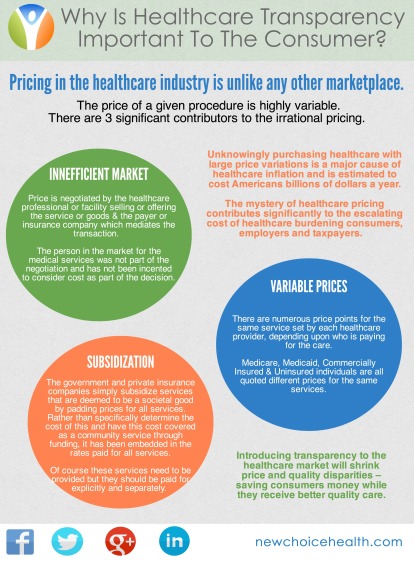Transparency in healthcare has become one of the most actively discussed topics today. The major questions have been:
- What should healthcare transparency look like?
- Why does healthcare transparency matter now?
- Why is it important to the consumer?
This is the final installment of New Choice Health’s three part article to answer these questions.
Why Is Healthcare Transparency Necessary?
Pricing in the healthcare industry is unlike any other marketplace. The price of a given procedure is highly variable. The most significant contributors to the irrational pricing for medical care are:
- The inefficient way in which transactions occur in the marketplace.
- A healthcare provider has many different price points for a given service
- Implicit subsidization within prices for all services for most hospitals who provide charity care and emergency services, etc.
Inefficient market
There are generally three players involved in the purchasing of a medical service. They are the healthcare professional or facility selling or offering the service or goods, the person receiving the services and the payer or insurance company which mediates the transaction. In any other normally functioning marketplace there are only two parties involved, the seller and the buyer (which is also the same person receiving the service). And when this is the case, the person buying the service can make decisions that will influence the seller to act in the buyer’s best interest….not so with healthcare, because the price was negotiated well before the transaction takes place and the person in the market for the medical services was not part of the negotiation and has not been incented to consider cost as part of the decision. As an example, would you participate in a transaction where you needed your car repaired and took it to a mechanic but had no idea how much it was going to cost because another person negotiated the price with the shop without your knowledge of the agreed upon price, only to find out the cost after the repairs were completed and you received the bill. Of course not.
As a result, normal price competition is absent, there is less focus on basic business management (i.e. cost vs. benefit) and consumers of healthcare don’t participate in decision-making. Due to their historical role in the process, there is a lack of ownership of the process and a lack of good information available even if they did want to be more actively involved.
Different prices for the same services
You begin see how messed up this market is and how difficult it would be for anyone to pinpoint what something should cost. This is where we get to the heart of it. There are numerous price points for the same service set by each healthcare provider, depending upon who is paying for the care. Below is a summary of how the predominant price points and payers stack up.
- List price. Medicare, Medicaid, nor Commercial insurers do not pay this price, as it is negotiated to a much lower rate.
- Prices for Medicare patients is commonly viewed as the closest to a cost based price
- Prices for Medicaid patients is usually set to a lower amount than Medicare pricing
- Commercial Insurers usually negotiate prices higher than Medicare prices, but much less than the provider’s charges. The real kicker is that a healthcare provider will likely negotiate different prices for the same procedure with each insurance company.
- The uninsured usually receive bills indicating that the providers list price is the price they pay, but a savvy healthcare consumer can easily get a discount, but nowhere near the three price points indicated above.
Subsidizing the cost of some services through broad price increases
Another factor influencing price dramatically, is that, over the years, both the government and private insurance companies simply subsidize services that are deemed to be a societal good by padding prices for all services. For example a hospital providing charity care to the uninsured and indigent or with emergency care will have infrastructure expenses that a surgery center does not have. Rather than specifically determine the cost of this and have this cost covered as a community service (ex. Fire Dpmt) through funding, it has been embedded in the rates paid for all services. Let me say that again. It is embedded in the cost of ALL services performed. Accountability for cost management is lost and this makes irrational pricing easier to mask. As an example, Medicare on average reimburses hospitals 35% more than a surgery center for the same procedure, much of this is to account for this subsidization. All private follow Medicare’s lead, so this practice is perpetuated. Of course these services need to be provided but they should be paid for explicitly and separately.
All of this combined results in unpredictable costs that very few have any insight into until after the bill for the care is received. Below is a real example that is repeated across thousands of cities around the country.
Average Prices for a Screening Colonoscopy at Different Facilities in the Same City
| Different facilities in the same city | List Price | Medicare Price | Medicaid Price | Insurance Company Contracted Price | ||
| Ins Co. A | Ins Co. B | Ins Co. C | ||||
| General Hospital | $5,089 | $1,152 | $979 | $1,384 | $1,237 | $1,091 |
| Surgery Center | $2,324 | $576 | $538 | $726 | $553 | $500 |
| GI Diagnostic Center | $3,486 | $864 | $820 | $1,089 | $829 | $750 |
Unknowingly purchasing healthcare with large price variations is a major cause of healthcare inflation and is estimated to cost Americans billions of dollars a year. The mystery of healthcare pricing contributes significantly to the escalating cost of healthcare burdening consumers, employers and taxpayers. Introducing transparency to the healthcare market will shrink price and quality disparities – saving consumers money while they receive better quality care. Quality is as important a factor as price, yet most consumers do not incorporate it into their healthcare decisions, largely because that information is not readily available. Online opinions of physicians and hospitals generally focus on wait times or communication skills rather than clinical qualifications and outcomes. The former makes you comfortable or uncomfortable; the latter can be costly, even deadly. New Choice Health intends to change that and provide consumers with the appropriate information depending upon the situation to inform decision making and empower them to become effective consumers in the emerging retail healthcare marketplace.
Stay connected to New Choice Health on Google+ & Facebook







